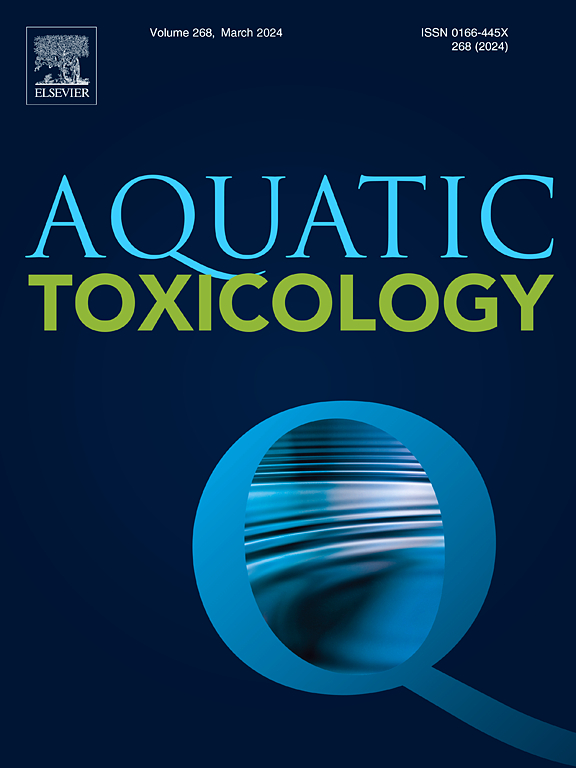Uptake, removal and trophic transfer of fluorescent polyethylene microplastics by freshwater model organisms: the impact of particle size and food availability
IF 4.1
2区 环境科学与生态学
Q1 MARINE & FRESHWATER BIOLOGY
引用次数: 0
Abstract
As an emerging contaminant, microplastics (MPs) are widely distributed in freshwater ecosystems and pose potential threats to aquatic organisms, attracting significant attention from both the scientific community and the general public. However, there is still uncertainty regarding the mechanisms of MPs transfer within aquatic biota and how particle size and food availability influence their transport patterns. In this study, zebrafish (Danio rerio) were selected as a model organism to investigate the uptake and elimination of fluorescent polyethylene (PE) MPs under different exposure scenarios (waterborne or trophic transfer, with or without food) and varying particle sizes (ranging from 10-300 μm at concentrations of 0.1, 2, and 300 mg/L). Additionally, water fleas (Daphnia magna) were provided as prey for the fish. The dynamic accumulation of PE-MPs sized between 10-20 μm at a concentration of 25 mg/L by daphnia was also determined along with its impact on animal feeding behavior. The results demonstrated that both organisms were capable of ingesting PE-MPs during exposures lasting up to 24 hours for daphnia and up to 72 hours for zebrafish. Furthermore, rapid elimination rates were observed within just 30 minutes for daphnia and between 6-12 hours for zebrafish. The presence of food reduced MPs uptake and removal by daphnia but significantly increased MP elimination by fish. Zebrafish showed a preference for ingesting larger-sized MPs that they could easily recognize; however, trophic transfer from daphnia to fish was found to be the primary route of ingestion specifically for PE-MPs sized between 10-20 μm. The findings suggest that while fish directly ingest fewer invisible MPs from the water column, they still accumulate these particles through predation on contaminated prey organisms. Therefore, it is imperative to prioritize the ecological risks associated with the transfer of MPs from zooplankton to fish.
淡水模式生物对荧光聚乙烯微塑料的吸收、清除和营养转移:颗粒大小和食物供应的影响。
作为一种新出现的污染物,微塑料(MPs)广泛分布于淡水生态系统中,对水生生物构成潜在威胁,引起了科学界和公众的极大关注。然而,关于微塑料在水生生物群落中的迁移机制,以及颗粒大小和食物可获得性如何影响其迁移模式,目前仍存在不确定性。本研究选择了斑马鱼(Danio rerio)作为模式生物,研究在不同的暴露情景(水传播或营养转移,有或无食物)和不同粒径(10-300 μm,浓度为 0.1、2 和 300 mg/L)下,荧光聚乙烯(PE)MPs 的吸收和消除情况。此外,还提供了水蚤(大型水蚤)作为鱼类的猎物。还测定了水蚤对浓度为 25 毫克/升、大小为 10-20 微米的 PE-MPs 的动态积累情况及其对动物摄食行为的影响。结果表明,在接触 PE-MPs 长达 24 小时(水蚤)和 72 小时(斑马鱼)期间,这两种生物都能摄取 PE-MPs。此外,水蚤和斑马鱼分别在 30 分钟和 6-12 小时内迅速消除了这些物质。食物的存在减少了水蚤对 MPs 的吸收和清除,但显著增加了鱼类对 MPs 的清除。斑马鱼倾向于摄取它们容易识别的较大尺寸的 MPs;然而,研究发现,从水蚤到鱼类的营养转移是摄取尺寸在 10-20 μm 之间的 PE-MPs 的主要途径。研究结果表明,虽然鱼类从水体中直接摄入的隐形多孔质微粒较少,但它们仍会通过捕食受污染的猎物生物来积累这些微粒。因此,必须优先考虑浮游动物向鱼类转移 MPs 所带来的生态风险。
本文章由计算机程序翻译,如有差异,请以英文原文为准。
求助全文
约1分钟内获得全文
求助全文
来源期刊

Aquatic Toxicology
环境科学-毒理学
CiteScore
7.10
自引率
4.40%
发文量
250
审稿时长
56 days
期刊介绍:
Aquatic Toxicology publishes significant contributions that increase the understanding of the impact of harmful substances (including natural and synthetic chemicals) on aquatic organisms and ecosystems.
Aquatic Toxicology considers both laboratory and field studies with a focus on marine/ freshwater environments. We strive to attract high quality original scientific papers, critical reviews and expert opinion papers in the following areas: Effects of harmful substances on molecular, cellular, sub-organismal, organismal, population, community, and ecosystem level; Toxic Mechanisms; Genetic disturbances, transgenerational effects, behavioral and adaptive responses; Impacts of harmful substances on structure, function of and services provided by aquatic ecosystems; Mixture toxicity assessment; Statistical approaches to predict exposure to and hazards of contaminants
The journal also considers manuscripts in other areas, such as the development of innovative concepts, approaches, and methodologies, which promote the wider application of toxicological datasets to the protection of aquatic environments and inform ecological risk assessments and decision making by relevant authorities.
 求助内容:
求助内容: 应助结果提醒方式:
应助结果提醒方式:


